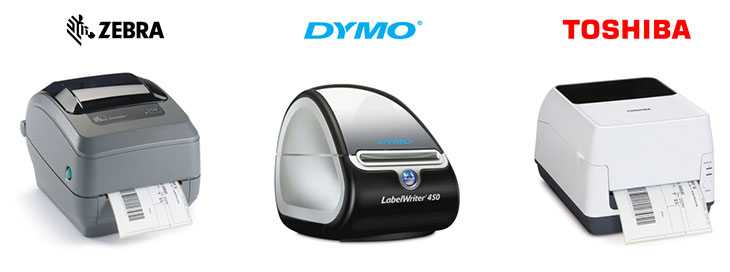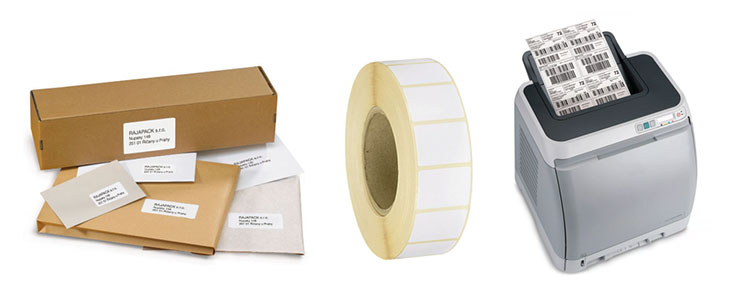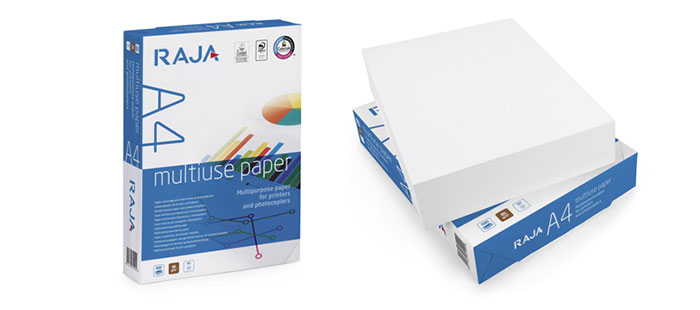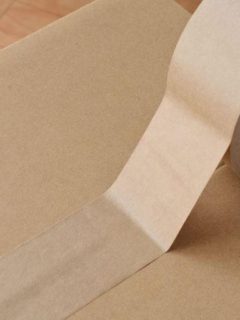You open a file, press ‘print’ and a few moments later your document magically rolls out of the printer. It seems simple although there is a lot of technology behind it. In this article, we look at the three most commonly used systems: laser, inkjet and thermal printing. What are the advantages of each technique and what kind of labels or paper do you need each time?
1. Thermal printing
► How does a thermal printer work?
Thermal printing uses heat to put a print on the paper. Thermal printers are used to create, for example, receipts, product labels, shipping labels, etc. In thermal printing, we distinguish two types of techniques.
| DIRECT THERMAL |
THERMAL TRANSFER |
| Use paper or labels coated with a special chemical layer. Contact with the heated print head triggers a chemical colour reaction which leaves a print.. | Due to the heat in the printer, the ink on the ribbon melts together with the paper. |
| Print is immediately dry after printing. | Printout lasts indefinitely. |
| Used for printing e.g. receipts. | Used to create barcode stickers or for coding products, boxes and pallets. |
Some popular thermal printers include those from: Zebra, Dymo and Toshiba.

► What are the advantages of thermal printing?
- Compact: because they are so small and light, these printers are easy to move around and barely take up space on your desk or packing table.
- Easy to maintain: they require no ink or toner cartridges.
- High print capacity: they can handle many prints per minute.
2. Laser printing
► How does a laser printer work?
Unlike the inkjet printer (which we cover below), the laser printer does not use ink, but toner. Toner is a type of powder that is applied to the paper and heated, causing it to fuse with the paper. The end result is a plastic print on the paper. This makes your printing more resistant to moisture and rain. No wonder laser printers are often used by e-shops for printing shipping labels or product stickers.
The name ‘laser printer’ is derived from the fact that these printers originally used laser light. Nowadays, LED light is also used for this purpose. The document or photo you want to print is projected by the laser onto the ‘drum’. This is a kind of round tube. At the spots where the drum is illuminated by the laser, the toner sticks. By then rolling the drum over the paper, the toner is transferred to the paper. Finally, heating ensures that the toner adheres firmly to the paper.

► What are the advantages of laser printing?
- Fast: higher printing speed compared to an inkjet printer.
- Quality: prints are waterproof and dry immediately after printing. This type of printing lasts longer and can be applied most accurately.
- Economical: printing with toner is cheaper than printing with ink (because you will have to replace a cartridge more often).
- Are all RAJA labels suitable for laser printers? Useful when you need to print larger quantities per day.
- There for e-commerce special shipping labels are designed for? They are a 2-in-1 solution: you print the invoice or delivery note together with the shipping or return ticket (suitable for laser and inkjet).
- There for difficult transport situations extra strong laser labels exist? They can handle all weather conditions and are suitable for outdoor use.
3. Inkjet printing
► How does an inkjet printer work?
An inkjet printer is the cheapest to buy and you often see it popping up in the average household or in smaller businesses. In this type of printer, tiny droplets of ink are sprayed onto the paper. Electric shocks cause the cartridge (which contains the ink) to drop a drop of ink at just the right spot. The space between those drops and the different colours next to each other ensure that we see light, dark and mixed colours.
Keep in mind that with this printing technique, the ink does not adhere as firmly to the paper. On contact with water, the ink may therefore bleed. It is best to avoid printing your documents double-sided as this will be detrimental to the quality of the paper and the print.

► What are the advantages of inkjet printing?
- Energy efficient.
- Versatile: is best suited to printing photos, among other things (however, this depends heavily on the type of inkjet printer you buy).
- Cheap: on average, this printer is the cheapest to buy. However, remember that you will need to replace ink cartridges more regularly.














